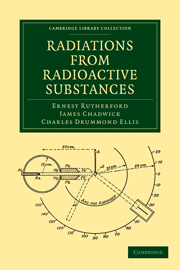Book contents
- Frontmatter
- Contents
- LIST OF PLATES
- Preface
- Chap. I Radioactive Transformations
- Chap. II The α Rays
- Chap. III Absorption of the α Rays
- Chap. IV Some Properties of the α Particle
- Chap. V Theories of Absorption of α Rays
- Chap. VI Secondary Effects produced by α Rays
- Chap. VII General Properties of the Radiations
- Chap. VIII The Scattering of α and β Particles
- Chap. IX The Collisions of α Particles with Light Atoms
- Chap. X The Artificial Disintegration of the Light Elements
- Chap. XI The Radioactive Nuclei
- Chap. XII β Ray and γ Ray Spectra
- Chap. XIII The Disintegration Electrons
- Chap. XIV The Passage of β Particles through Matter
- Chap. XV The Scattering and Absorption of γ Rays
- Chap. XVI Intensity Problems connected with the Emission of γ Rays
- Chap. XVII Atomic Nuclei
- Chap. XVIII Miscellaneous
- Appendix
- Subject Index
- Index of Names
- Plate section
Chap. IV - Some Properties of the α Particle
Published online by Cambridge University Press: 07 September 2010
- Frontmatter
- Contents
- LIST OF PLATES
- Preface
- Chap. I Radioactive Transformations
- Chap. II The α Rays
- Chap. III Absorption of the α Rays
- Chap. IV Some Properties of the α Particle
- Chap. V Theories of Absorption of α Rays
- Chap. VI Secondary Effects produced by α Rays
- Chap. VII General Properties of the Radiations
- Chap. VIII The Scattering of α and β Particles
- Chap. IX The Collisions of α Particles with Light Atoms
- Chap. X The Artificial Disintegration of the Light Elements
- Chap. XI The Radioactive Nuclei
- Chap. XII β Ray and γ Ray Spectra
- Chap. XIII The Disintegration Electrons
- Chap. XIV The Passage of β Particles through Matter
- Chap. XV The Scattering and Absorption of γ Rays
- Chap. XVI Intensity Problems connected with the Emission of γ Rays
- Chap. XVII Atomic Nuclei
- Chap. XVIII Miscellaneous
- Appendix
- Subject Index
- Index of Names
- Plate section
Summary
§ 22. Retardation of the α particle. The great majority of α particles in passing through matter travel in nearly straight lines and lose energy in ionising the matter in their path. Occasionally an α particle suffers a nuclear collision with an atom and is deflected through a large angle. These occurrences, though of great interest, are so rare that they do not seriously influence the average loss of energy when a large number of α particles are under examination. The laws of retardation of the α particle are best studied by making use of the homogeneous α radiation emitted by the very thin deposits of radium C, thorium C, and polonium. It is found experimentally that the reduction of velocity in traversing normally a uniform screen is nearly the same for all the α particles, so that a homogeneous pencil of rays remains nearly homogeneous on emerging from the screen. This effect is most clearly shown with the swifter α particles, e.g. those that have a range in air between 8·6 and 3 cm. With reduction of the velocity, the “straggling” of the α particles, i.e. inequalities in the velocity and range of the emergent α particles, becomes more and more prominent and the issuing pencil of α particles becomes very heterogeneous. The reduction of velocity is best studied by an arrangement similar to that shown in Fig. 7, where the absorbing sheet of matter is placed over the source and the deflection in a uniform magnetic field of the issuing pencil of α rays, in an exhausted chamber, is observed either by the photographic or the scintillation method.
- Type
- Chapter
- Information
- Radiations from Radioactive Substances , pp. 101 - 133Publisher: Cambridge University PressPrint publication year: 2010First published in: 1930



